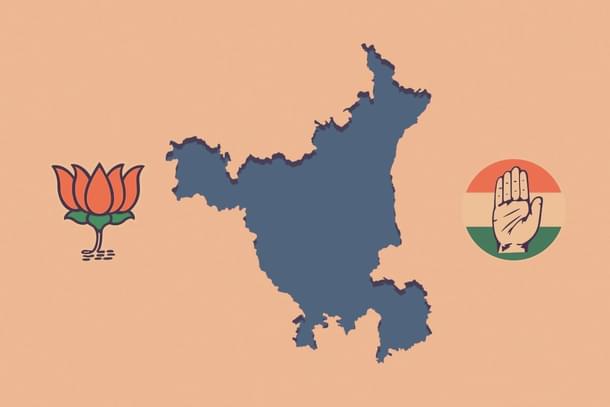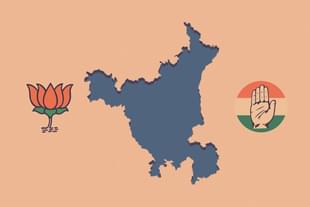Politics
Six Key Takeaways And Four Crucial Questions To Explore From The Haryana Results
Arush Tandon
Oct 08, 2024, 05:54 PM | Updated Oct 12, 2024, 11:54 PM IST
Save & read from anywhere!
Bookmark stories for easy access on any device or the Swarajya app.


1. For you to win, act like the other guy is going to
The primary lesson from 'Lok Sabha 2024' and Haryana today is that consolidation is a necessary but not sufficient condition for an electoral victory. What is also needed is the management of the optics around it.
For an electoral win, both the core and the incremental vote is needed. Putting in the ground work consolidates the core voters behind a party but managing the optics of it brings in the incremental vote.
What is meant by the 'managing the optics'?
Say you are going to win, but act like the other guy will. There is a fine line between sounding re-assuring and cocky. Do not cross it. Inside the line, are your core and incremental votes, both. Outside it, there are no incremental votes and there is an attrition of the core votes too.
The common-sense reading based on numbers from Haryana (at the time of writing) is that the Congress overplayed their hand on Jat consolidation. That spooked all other communities and the result of that is what we are witnessing. Sympathy is evoked, not demanded.
Traditionally the Jats in Haryana have been a vocal, dominant, landed community. Such groups are always more vulnerable than others in triggering a counter-consolidation against them in elections.
Are the Marathas watching?
2. Nary a blip on the civilisation timeline
Those who are reading the Haryana result as a vindication of a political consciousness amongst the Hindu voters should not get too ahead of themselves. Just as they should not have been overly despondent on 4 June.
All said and done, from the available data and analyses so far, this still looks like an election decided primarily by caste identities. Just that the BJP was the beneficiary this time.
Political consciousness amongst Hindus is still a long way off. At the same time, it is not a futile project either. We are five days away from celebrating Dussehra at the Ram Janmabhoomi—with full rituals and splendour—after 500 years.
3. Its organisation gives BJP a resilience in Haryana
A 40 per cent vote share after beating a two-term incumbency shows the BJP's ground strength in Haryana. Such a result is not possible merely as a result of last-minute politicking.
What makes this even more remarkable is that 15 years ago, in 2009, the BJP won only four seats with a vote share of 9 per cent. It was only the fourth-largest party in the state. From there, its vote share went up to 33.3 in 2014 and 36.7 in 2019. This time, after all the narrative of BJP being voted out, its vote share actually increased to 39.92 per cent.
Keep in mind also that in this election, the BJP has strategically given relatively weaker candidates in some seats to damage the Congress. Hence, this 40 per cent vote share is most likely the lower end of the actual range of support for the BJP.
'Haryana 2014' was arguably the BJP's most remarkable victory in assembly election, ever. Now, 'Haryana 2024' also lays claim to that title.
4. Non-dominant community CM is cool again
This approach of the BJP had become unpopular due to real or imagined complaints with the performances of CMs like Raghubar Das and Manohar Lal Khattar. But Haryana's result today has shown that the strategy still carries value.
Secondly, credit of the victory must also go to Naib Singh Saini. He was made to assume the post at the cusp of the Lok Sabha elections where the BJP suffered a setback in Haryana. Following that, the narrative that Saini's government would be voted out in the Assembly picked up steam. It would be natural for a leader to panic in such a scenario and concede to all kinds of pressures.
Evidently, Saini did not do that and led a strong campaign in the state.
5. BJP can win even if election is not made 'national'
The results of the Lok Sabha elections in summer appeared to be imparting the lesson that a plan to electorally defeat the BJP must involve making the election as local as possible. 'Don't let Modi nationalise it'.
'Haryana 2024' was as locally contested an election as any in recent memory. Modi addressed far fewer rallies this time than he did in 2019. Yet, the BJP is comfortably ahead of the majority mark in Haryana.
Clearly, localising the election is not an assured antidote to a BJP victory.
6. Exit polls are useless
********
Now, the questions
1. Has an antidote to J.A.U.H. been discovered?
J.A.U.H. stands for 'jitni abadi, utna haq', one of Rahul Gandhi's favourite phrases since the beginning of the year. He raised the slogan in the Haryana campaign as well but evidently it has not been as effective.
One reason for this is that the same cheque cannot be cashed twice. It is extremely rare for a leader to find success twice with the same campaign.
Second, since the Lok Sabha results, the Naib Singh Saini government made multiple concessions to 'freebies'. From loan waivers to free bus rides to unemployment allowances, Saini matched Congress on the hand-outs front.
'J.A.U.H.' becomes difficult to counter if you have an image of a fiscally conservative government. The 'freebie' approach is not the ideal scenario, but it is what is there for now.
2. What really happened between June and October?
The optimistic explanation (called 'whitepill' in social media lingo) for the Lok Sabha election results for Modi- and BJP-supporters was that is was the letting off of steam in the system without the BJP actually losing power. It was the people venting out whatever frustrations they had with Modi. And once they had vented, once they had said their piece, they were able to think and choose normally again.
There is also the theory of buyer's remorse. It might well be possible that a large number of people did not vote BJP in April-May, or did not vote at all, thinking that even without their vote the Modi would be back with 350 seats.
While Modi was back, this was not a simple BJP majority government. On the other end, the voter saw the chest thumping of the Opposition and visible assertion of Islamists on the streets.
The question thus is—were a considerable number of voters hit with pangs of guilt between June and October?
A reasonable answer to this question can be obtained if we know how many assembly seats did the BJP lose in May, that they won back in October?
3. Where for Jat politics now and did it peak too early?
It's been 10 years since Haryana had a chief minister from the Jat community. It is almost certain that it will not have one for another five years.
This brings us the to the question: what happens to the politics of Jat consolidation now? Keep in mind the last four years have been particularly eventful for this brand of politics:
The 'farmers'' and the wrestlers' agitation created a perception of the community being constantly at loggerheads with Modi. They were also supposed to be the preceding acts building upto the climax of the Haryana assembly election.
Which brings us to the next question: did this politics of Jat consolidation in Haryana peak in May itself? Or was it the peak in May that led to a counter-consolidation in October?
Did Bhupender Singh Hooda prove his mettle in May when he actually had to do it in October?
4. Did urbanisation in Haryana play a role?
A change in socio-political attitudes and choices, brought about by economic growth and urbanisation, is too slow a process to be observed in real time. But like all such changes, it is impossible to reverse.
Previous elections show that as an electorate climbs the income ladder, gets more urbanised and more educated, it is more likely to vote for the BJP (where the BJP is a serious political contender). We also know that in the last 20 years Haryana has outperformed its hitherto more prosperous neighbour, Punjab, on both GSDP and per capita income terms.
Is the BJP's resilience in Haryana a result of this deeper underlying change? The BJP has won handsomely in the Gurgaon region and the GT road belt in Haryana. Do these regions being relatively more urban than the rest of the state have anything to do with the BJP's wins here?
Arush Tandon is interested in icons of history, history of independent India and, Indian culture.





